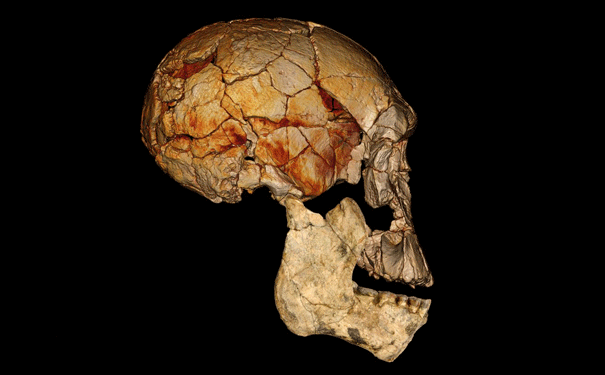
The KNM-ER 1470 cranium, discovered in 1972, combined with the new lower jaw KNM-ER 60000; both are thought to belong to the same species. The lower jaw is shown as a photographic reconstruction, and the cranium is based on a computed tomography scan. Credit: © Photo by Fred Spoor
New fossils shed light on human evolution and solve a 40-year-old mystery.
Three new fossils, which were discovered near Lake Turkana in Kenya, indicate that there were at least two other Homo species living alongside our ancestor two million years ago. The fossils, which were discovered by the Koobi Fora Research Project (KFRP), consist of a lower jawbone, part of a second lower jaw and a face.
The results of the discovery, which was published in Nature, may help solve the debate about whether one or two species, apart from Homo erectus, existed at the base of human lineage. They have been dated to have been dated to 1.95-1.78 million years ago and would have lived alongside our early ancestor in Kenya.
In 1972 the KFRP unearthed a fossil, known as KNM-ER 1470 (1470), 10 kilometres from where the new fossils were located. This individual would have lived alongside Homo erectus, but its long flat face indicated that it could be a separate species. However, as it was only a single individual with a missing lower jaw, it could have simply been a weird member of a variable species.
“We had always suspected that 1470 was a separate species, but because we could not find any other fossils that matched its unique features we could not be sure,” explains Meave Leakey, co-leader of the KFRP. “With these additional fossils which give us details of the teeth and the lower jaw, which 1470 lacked, we can now say that these fossils represent a distinct species.”
The three new fossils, which have similar features to the original skull, give a much clearer picture of what 1470 would have looked like. The confirmation that this is a separate species, which was named Homo rudolfensis in 1986, indicates that there was more than species of Homo at the base of human evolution and may help scientists unravel how our branch of evolution first emerged almost two million years ago.
“These discoveries address the base of the human lineage when the first species of our own genus emerged,” Leakey says. “They show that, as in other mammalian lineages, evolution proceeded with radiations of species after the evolution of new innovations. Thus the increase in brain size that characterises the genus Homo began a little over two million years ago and at this time we see the first appearance of several species of Homo.”
This diversification was eventually followed by extinction, so that only Homo erectus survived to eventually evolve into modern-day humans. The discovery may help them understand how humans developed the characteristics that have enabled them to survive while other members of our genus disappeared.






